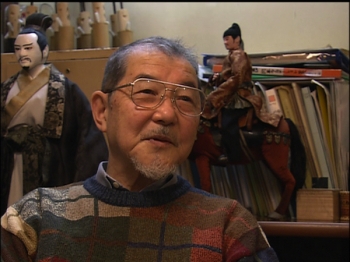The story begins, and is set in the Nara period (710 – 784) in the time when Buddhism was being introduced into Japan from China and Korea. The viewer follows a noble daughter of the second house of the Fujiwa Clan named Iratsume, who discovers the newly introduced teachings of the Buddha and becomes quite devoted in her practice. With great dedication and passion, she commits herself to copy thousands of times the Amida Sutra, and in so doing has sleepless nights and stops communication with her friends. In the course of her sutra copying and with her fervent devotion to the Buddha, she sees a radiantly shining figure of the Buddha appear over the twin peaks of the holy Mt.Futakimi. It would appear that in her piety she knew not of the storm that raged outside and the severe cold to visit the sacred temple.
Another important character in the film is that of Prince Otsu, who had been assassinated years before by an emperor’s widow who planned his death to allow her own son to inherit the royal throne. Prince Otsu in the film is a wandering spirit who has a special connection with Iratsume because their eyes met in the moments before his death – he had loved her and is strongly attached to her being. Every time that Prince Otsu appears to her, in spite of her fear, she sees him as a manifestation of the Buddha, and in her unconditional devotion to the Buddha, she chants the Amida Sutra for comfort. Here there is a lesson from the Buddhist teachings to explore about karma, and the important last moment before death, which is very influential in deciding re-birth. We review our attachments in life, and reflect upon what keeps us wandering in cycles of birth and death.
Eventually in the film, Iratsume constructed a large cloak to keep the memory of the Buddha with a thousand Bodhisattvas painted upon it. After the completion of the work, she sheds a tear and walks out of the room. This action suggests that we should live in, and find the beauty in the present moment without attachment to the divine and secular world, or worrying about the future either. This is a central philosophy of the Buddhist teachings to reflect upon.
















